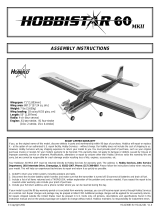Page is loading ...

ASSEMBLY OF YOUR P-51 MUSTANG RUBBER BAND POWER AIRPLANE
➊ Assembling The Wing,Tail
and Fuselage
Remove the backing paper from the double
sided tape indicated by the shaded sections
shown on the drawing. Assemble all parts
shown by pressing them firmly into place to
ensure good adhesion.
Apply the decals using the pictures
on the box as a guide.
➋ Assembling The Propeller
And Motor
Remove the rubber band motor holder
from the rubber band motor. Attach the
rubber band motor to the hook on the
back of the propeller hub.
➌Winding The Rubber Motor
Wind the rubber motor by turning the
propeller clockwise. Start with 60- 100
turns for a short test flight.The maximum
number of turns is 200.
➍➍
Changing The Rubber Motor
If you should break a rubber band
motor, you can change it using the wire
hook as shown above. A spare rubber
band motor is included in the kit.
Entire Contents © Copyright 1999 HCAZ3086
Tail
Fuselage
Wing
Propeller
Rubber Band
Motor
Rear Rubber
Motor Holder
Wire
Hook
Hook
Rubber Band
Motor Holder

TRIMMING YOUR P-51 MUSTANG (Must be done before flying!)
TEST FLYING YOUR P-51 MUSTANG
➊ It is important to test, or trim, your P-51 correctly. The airplane
should climb and turn efficiently.
➋ Using a hobby knife, carefully cut only the top and bottom of
the rudder and the inside and outside ends of both elevators.
➌ Before winding the rubber motor, grasp the airplane body and
gently toss the airplane into the wind. It should glide straight ahead
and settle gently to the ground. See diagram below.
1.Take your P-51 out into the middle of a
field. Wind the rubber motor. Hold the
P-51 over your head and release the
propeller. Toss the airplane into the
wind, keeping the airplane level.
2.The airplane should climb gently and
turn gradually. If it stalls or crashes,
adjust the elevator. If it does not turn,
bend the rudder 1-2 mm to the left
or right. Refer to “Trimming your
P-51" for details.
IMPORTANT THINGS TO REMEMBER
WHEN YOU ARE FLYING YOUR P-51:
The most important thing that determines
how well your P-51 flies is how well you
have trimmed it out.
Because it can fly high and far you must
be in a large area away from houses,
streets, trees, and overhead wires.
Closely inspect your P-51 after every
flight. Make sure the wings are not
broken and are securely fastened to the
airplane body. Make sure none of the
tail parts are broken. See the REPAIR
section for details.
Always throw the P-51 into the wind.Do
not fly the P-51 if it is too windy.
CAUTION
• DO NOT FLY NEAR POWER LINES.
• ALWAYS LAUNCH PLANE AWAY
FROM PEOPLE AND OBSTACLES.
• NEVER POINT THE PLANE AT
ANYONE OR ANYTHING.
• ALWAYS LAUNCH SKYWARD.
• DO NOT LAUNCH INDOORS.
REPAIR
Repairs can be made to your model
using clear tape. You may also use
white PVA glues or epoxy. Never use
polystyrene cements or “super” glues
as they will melt the styrofoam.
Wind
direction
A = Crash. Bend elevators upward 1-2mm.
B = Stall. Bend elevators down 1-2mm.
C = Correct flight path.
D = To veer left, bend rudder slightly to the left.
E = To veer right, bend rudder slightly to the right.
➍➍
Repeat step 3 until proper flight is achieved.
A
A
B
B
C
D
D
E
E
/










